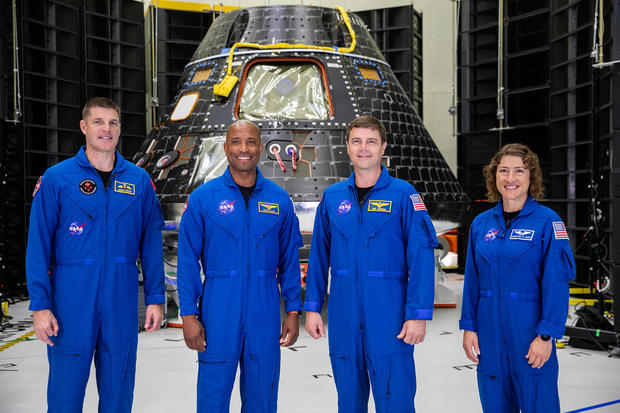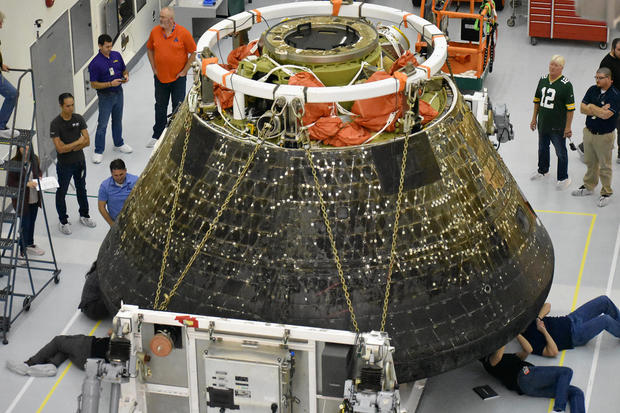NASA delays first Artemis astronaut flight to late 2025, moon landing to 2026
NASA's first crewed Artemis mission, a flight to send four astronauts on a voyage around the moon and back, is being delayed nearly a year, from late 2024 to at least September 2025, NASA announced Tuesday. Likewise, the first astronaut moon landing is slipping from late 2025 to September 2026.
"As we remind everybody at every turn, safety is our top priority," NASA Administrator Bill Nelson told reporters during an afternoon teleconference. "To give Artemis teams more time to work through the challenges with first-time developments and integration, we're going to give (them) more time on Artemis 2 and 3.
"We are adjusting our schedule to target Artemis 2 for September of 2025 and September of 2026 for Artemis 3, which will send humans for the first time to the lunar south pole. Artemis 4 remains on track for September 2028, and though challenges are clearly ahead, our teams are making incredible progress."
Rumors of delays had been circulating for months, and the Government Accountability Office reported late last year that delays were a virtual certainty. But the dates announced Tuesday pushed the flights back further than many expected.
Plan to send astronauts to the moon
NASA launched the Artemis program's first test flight, Artemis 1, in November 2022, using the agency's powerful Space Launch System heavy lift rocket to send an unpiloted Orion crew capsule on a flight around the moon and back.
NASA had planned to launch the Artemis 2 mission at the end of this year to carry a three-man one-woman crew on the first piloted Orion flight, a shakedown mission to test the spacecraft's life support, propulsion and other systems in Earth orbit before pressing ahead for a deep space loop around the moon and back.
But mission managers opted to delay the launch to give engineers more time to resolve an issue with the Orion capsule's protective heat shield that was found after the Artemis 1 re-entry. They also need to correct more recently discovered problems with critical batteries that were found while testing units intended for the Artemis 3 Orion.
The heat shield is designed to ablate, or char, during re-entry heating when returning from the moon at speeds of more than 25,000 mph. During the Artemis 1 re-entry, more charred material separated from the heat shield than computer models predicted.
While the unexpected "liberation" had no impact on the spacecraft — NASA said astronauts would not have even noticed it had any been on board — engineers want to make sure they understand the underlying cause so that updated computer models can accurately predict re-entry effects across multiple trajectories.
Amit Kshatriya, deputy administrator of NASA's Moon to Mars Program, said engineers are closing in on the root cause of the unexpected behavior. The launch delay was primarily caused by the battery issue and the disassembly required to access and replace them amid a myriad of complex subsystems.
"That Artemis 2 crew will be the first people to set human eyes on the far side of the moon (since Apollo), and I can't imagine all the pictures and recordings that they'll bring back to capture those moments, but also to inform our understanding of the moon," said NASA Associate Administrator Jim Free,
"The crew is a constant reminder for us of how important it is to remain focused on the work we need to do to ensure their safe return."
SpaceX building Starship lunar lander
As for the Artemis 3 lunar landing flight, the late 2026 target assumes SpaceX's Starship lunar lander — a vehicle that has not yet been operated in space — successfully completes multiple test flights in Earth orbit, along with at least one unpiloted lunar landing demonstration in 2025.
The Human Landing System, or HLS, is a variant of the Starship upper stage SpaceX is building that will launch atop the company's gargantuan Super Heavy booster.
The HLS, being built under a $2.9 billion NASA contract awarded in 2021, will use up all is cryogenic methane and liquid oxygen propellant just getting to low-Earth orbit. To make it to the moon, the rocket must be robotically refueled.
Jessica Jensen, SpaceX vice president of customer operations and integration, said on the order of 10 Super Heavy-Starship "tanker" flights will be needed to carry up the propellants needed to refuel the HLS.
"It will roughly be 10-ish," she said. "That would be my rough guess right now. But it could be lower depending on how well the first flight tests go or it could be a little bit higher."
The ultra-cold propellants, which continually boil away, must first be transferred, one flight at a time, to a storage vehicle of some sort. When enough propellant is available, the HLS will be launched, refueled from the depot and then take off for the moon where it will await the arrival of an Orion crew.
SpaceX's first two Super Heavy-Starship test flights last year were only partially successful and neither upper stage Starship made it all the way to the planned sub-orbital trajectory. Jensen said a third test flight is planned for February, pending FAA approval, followed by the start of propellant transfer test flights later this year.
"Crew safety is paramount"
Under the revised Artemis 3 schedule, an unpiloted HLS test flight to the surface of the moon and back is planned for sometime in 2025.
"Crew safety is paramount," Jensen said. "So we want to ensure we do as many flight tests as we possibly can just on the Starship vehicle in general, but also do the uncrewed landing to the moon with Starship before Artemis 3."
Under the Artemis program, NASA plans to establish a sustained presence on the moon, sending astronauts on a regular basis to the south polar region where scientists say ice deposits may be present in permanently shadowed craters.
If such deposits are confirmed, solar or nuclear power could be used to break the ice down into hydrogen and oxygen, providing air, water and rocket fuel for future deep space explorers. Ice deposits could vastly reduce the cost of such missions compared to launching the resources from Earth.
China has similar plans to explore the moon's south pole, saying its first piloted landing mission is planned for 2030. Asked if he was worried China might win the latest space race, Nelson said "I really do not have a concern that China's going to land before us."
"I think that China has a very aggressive plan," he said. "I think they would like to land before us because that might give them some PR coup. But the fact is that I don't think they will."






